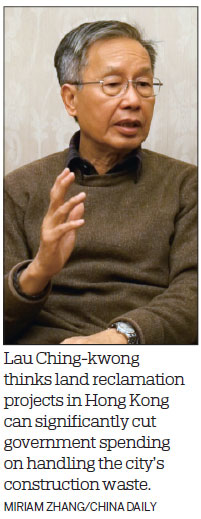Hong Kong land reclamation can save money by turning waste into building material
Updated: 2019-01-14 07:54
By He Shusi in Hong Kong(HK Edition)
|
|||||||
Hong Kong ships millions of tons of construction waste every year - at high cost - to the Chinese mainland because the city has run out of space to dump it. However, reclamation projects such as "Lantau Tomorrow Vision" can turn that waste into building material and save the special administrative region government hundreds of millions of dollars in the process, Lau Ching-kwong, former director of the Civil Engineering Department, told China Daily.
Waste - the inevitable by-product of new construction - is expensive not only in the high price to ship it away from the city, but also in the carbon dioxide the cargo ships that move it produce every day, Lau said.
The veteran engineer, who was in charge of the land reclamation project for Hong Kong Disneyland in 2000, noted that the city has been paying millions of Hong Kong dollars per year on shipping construction waste that the city could not handle to Taishan city in Guangdong province.
Taishan, 170 kilometers west of Hong Kong, turned the free gift into over 660 hectares of reclaimed land. That is equivalent to more than 34 Victoria Parks, according to a Legislative Council document submitted by the Task Force on Land Supply in November 2017.
Construction waste is generated by local construction, excavation, renovation, demolition and road works. Hong Kong produces about 15 million metric tons of construction waste per year.
According to the Civil Engineering and Development Department, about 90 percent of construction waste is suitable for land reclamation. Secretary for Development Michael Wong Wai-lun said Hong Kong would gain 60 hectares of reclaimed land annually if the annual construction waste could be used.

Major reclamation projects ceased in Hong Kong after 2000, and the two fill banks built for storing construction waste are on the verge of saturation. As a result, Hong Kong has been transporting the waste to Taishan since 2007.
As of May last year, about 119 million tons of public fill had been delivered to Taishan, according to the Civil Engineering and Development Department.
The price for Hong Kong to ship this material to Taishan was HK$70 per ton in 2011, while cargo ships produce 50 tons of carbon dioxide per day, according to then-secretary for development Carrie Lam Cheng Yuet-ngor, now the SAR's chief executive. The government has since not updated transportation fee for the waste.
"We have been paying hundreds of millions of Hong Kong dollars every year for other cities' reclamation work," Lau, who's also a fellow of the Hong Kong Academy of Engineering Sciences, concluded.
Lau was the major person to talk to the State Oceanic Administration and promote the Taishan project back in the early 2000s, when his proposal to reuse the waste in reclamation projects in the city was rejected.
Taking office as director of the Civil Engineering Department, Lau and his team proposed building an artificial island off the southern coast of Cheung Chau Island in late 2000.
But the plan was widely criticized by environmental protection groups and fishermen. Lau turned to the mainland authorities, asking for their help to take the construction waste.
"It was not easy. I went to Beijing to talk to various officials for a long time. These included the customs and immigration, as it was cross-boundary delivery," Lau said.
Lau retired from the government in late 2002.
"I have retired for so many years. If the (Hong Kong) government had made use of these construction wastes for land reclamation, even little by little, there would have been a lot of new lands now," he said.
Noting that the public's major concern over reclamation is its impact on the environment, Lau said there are various ways to minimize it, especially with the latest technologies and marine engineering equipment.
"After all, there isn't enough land in Hong Kong. Reclamation is the best and fastest solution to creating a large chunk of land, without affecting as many people as developing the brownfields," he added.
Lau hoped the government can start feasibility research on the proposed "Lantau Tomorrow Vision" project as soon as possible, and carefully cope with possible impact on the environment and the fisheries industry.
heshusi@chinadailyhk.com
(HK Edition 01/14/2019 page6)